Philodendron Ring of Fire, with its fiery swirls and bold foliage, is impossible not to love. It’s unique enough to be pretty difficult to find, but if you do find one, count yourself lucky.
Rare and interesting houseplants don’t have to be difficult to care for. We’ll walk you through everything you need to know about Philodendron Ring of Fire, from its extra colorful variant to the best tips for helping it thrive.
Whether you’re a seasoned plant parent or a budding gardener looking to add some extra pizzazz to your collection, we’ll answer all your burning questions about Philodendron Ring of Fire care!
Table of Contents
Philodendron Ring of Fire Plant Care Guide
History, Habitat, and Characteristics
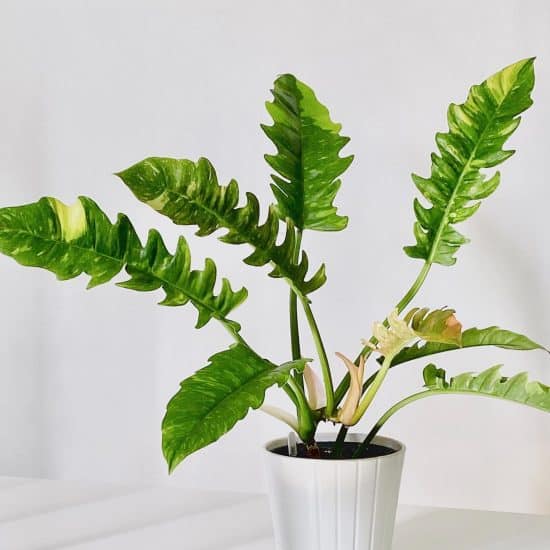
Philodendron Ring of Fire (Philodendron tortum x Philodendron wendlandii) is an aroid plant that sets hearts ablaze with its sectoral variegation. Its long, striated leaves have a scalloped edge, but it’s the colors that make this rare plant so coveted.
With leaves that look like they’re on fire, Philodendron Ring of Fire displays up to five distinct colors: green, yellow, orange, red, and an extra mystery hue. (See if you can spot it in the pictures.)
Patience is key with Philodendron Ring of Fire. New growth on this slow-growing plant can take its time. But the reward is well worth the wait!
Although the Philodendron Ring of Fire is an absolute stunner, some think it’s a bit too hot to handle when it comes to propagation. But don’t let that deter you! With an air-layering technique, most plants can be coaxed into new growth.
Because Philodendron Ring of Fire is a hybrid itself, there aren’t many varieties. There is one notable variety, though, called the Golden Ring of Fire Philodendron. It flaunts even bolder coloring, further fanning the flames of this plant’s popularity.
Light
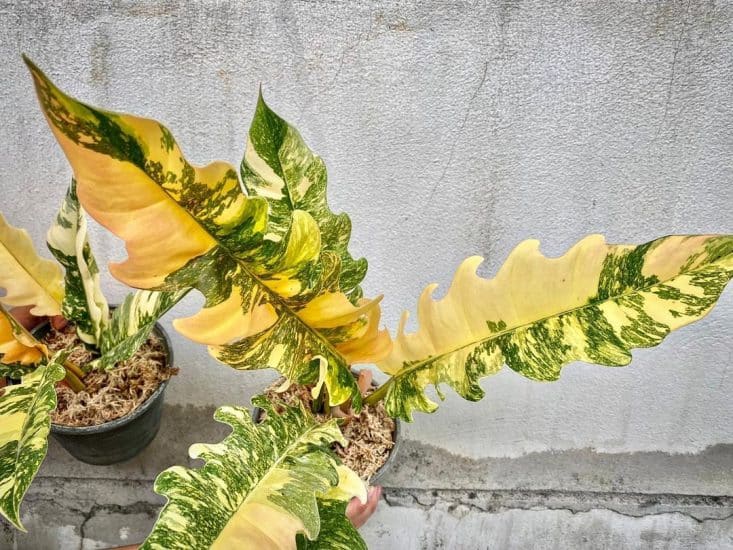
Philodendron Ring of Fire hails from the rainforests of Central and South America, where it basks in dappled light beneath the forest canopy.
To recreate these light conditions, place your Ring of Fire in bright, indirect light. Near, but not directly in front of, a south-facing window works well, and an east- or west-facing window will also suffice, with a sheer curtain if necessary. No matter what exposure you give it, keep it out of direct sunlight.
If your Philodendron Ring of Fire’s leaves appear sun-bleached, lose their bright colors, or develop a faded and scorched look, it’s probably getting too much direct sunlight. Try moving the plant to a slightly shadier spot or use a sheer curtain to filter any harsh sunlight, ensuring the perfect lighting balance.
Conversely, if your Ring of Fire plant is getting insufficient light, you may notice slow-growing stems and leaves that reach out toward any available light source. In this case, it’s essential to move your plant to a brighter location with more light, or enhance its lighting with full-spectrum LED grow lights.
Don’t hesitate to experiment with different locations. Light requirements are general, but each home is different. We’re confident that with a bit of patience, you can find the perfect Ring of Fire light conditions in your home.
Water
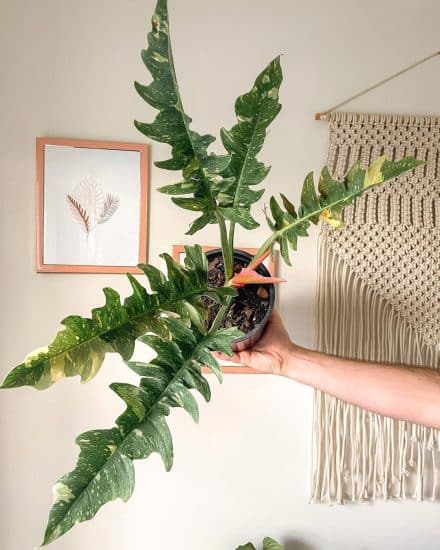
Philodendron Ring of Fire prefers an evenly moist soil that doesn’t stay soggy.
Water your Ring of Fire when the top inch of soil is dry. Feeling the potting mix with your fingers helps to avoid overwatering, which isn’t good for any plant. You’ll know you’ve watered your plant enough when the water flows from the bottom of the pot. After that, wait for the top to dry again.
Be cautious with tap water, which contains fluoride and chlorine. If you must use tap water, allow it to sit out for 24 to 48 hours so the chlorine will evaporate. Better yet, water your plants with filtered, or even distilled, water if you have it.
If your plant isn’t getting enough water, the oldest leaves close to the base of your Philodendron Ring of Fire may turn yellow or the leaf edges may curl up. In this case, remove any dying leaves to avoid attracting pests, and increase the watering frequency and amount, but be sure to keep an eye on the soil. You don’t want to overcorrect.
Too much water can cause yellowing leaves throughout the Philodendron Ring of Fire, along with mushy stems, consistently damp soil, and potential damage to the plant’s roots. Cut back on watering frequency and let the soil dry out before watering again.
Temperature and Humidity
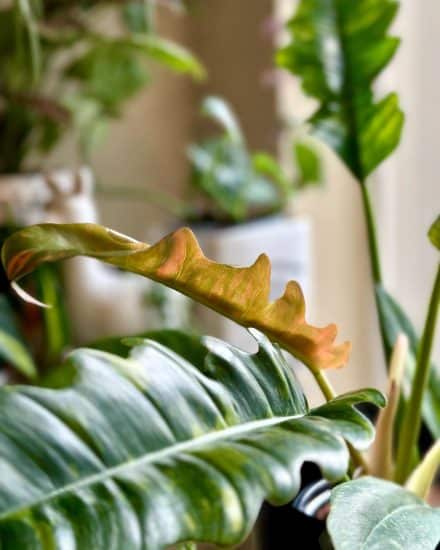
The Philodendron Ring of Fire thrives in a warm temperature range of 65-80°F (18-27°C). As a tropical plant, it’s sensitive to temperature fluctuations, especially cold drafts. If the temperature isn’t right, you may notice wilting, yellowing leaves, or stunted growth. Central heating can be helpful, but make sure not to place the plant too near heat sources to avoid heat stress.
Your Philodendron Ring of Fire needs a high humidity level of around 60% or more. When humidity is too low, you may see curling or browning leaf edges or crispy tips. But be careful not to overdo it, since excessive humidity can result in mold or rot. Finding the right balance is key.
To raise humidity:
- Use a pebble tray filled with room-temperature water to create a microclimate of increased humidity as the water evaporates.
- Group plants together to encourage shared moisture through transpiration, which naturally raises humidity levels for all the plants.
- Consider using a humidifier, especially during the winter when indoor air is often dry.
- Keep the plant away from air vents or drafts that may lower humidity levels.
Soil and Planting
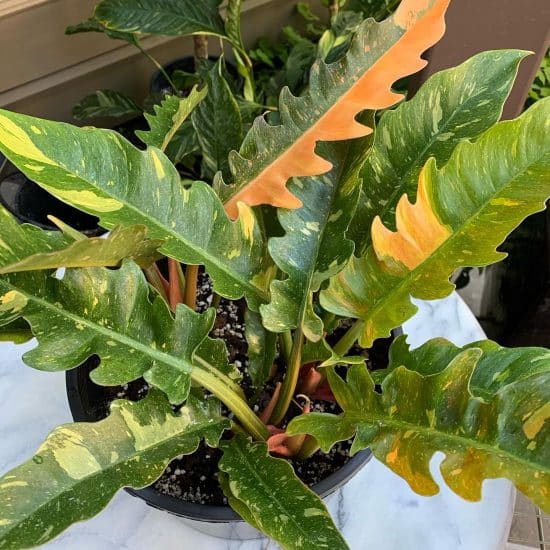
The ideal soil for Philodendron Ring of Fire is a regular, well-draining soil mix like Pro Mix HP, which contains perlite, mycorrhiza, and essential nutrients. Perlite improves aeration, drainage, and prevents soil compaction, while mycorrhiza, a symbiotic fungus, helps the plant absorb nutrients and water more efficiently.
You can also add those elements to a regular potting mix along with coconut coir, worm castings, and orchid bark. Both help retain moisture, and coco coir is far more eco-friendly than peat moss — harvesting the latter damages essential carbon sinks.
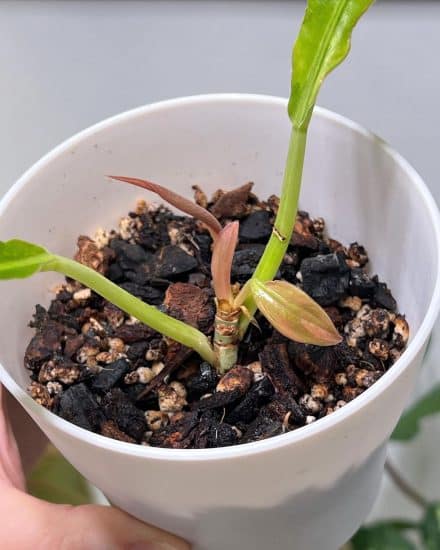
When your Ring of Fire eventually outgrows its pot, you’ll need to repot, preferably in spring and summer. A ceramic pot is best because it maintains soil moisture well. Be careful not to choose a pot that’s too big. Excessive amounts of soil can lead to overwatering, and excess water can lead to rot issues.
Climbing philodendron plants like Ring of Fire need a houseplant pole to support their climbing habit. These are best added during repotting so that you can anchor it well deep in the soil. Avoid letting Ring of Fire hang due to its delicate stems.
Fertilizing
Apply a balanced liquid houseplant fertilizer, diluted to half strength, monthly during the growing season. Decrease or halt fertilizing during winter months, when the plant will be dormant and won’t require extra nutrients.
Fertilizing your Philodendron Ring of Fire is crucial, but watch for signs of excess, like yellowing leaves, brown tips, and slower-than-normal growth. If you notice any of these, flush the soil with water to remove excess fertilizer and allow the plant to recover before resuming feeding.
Propagation
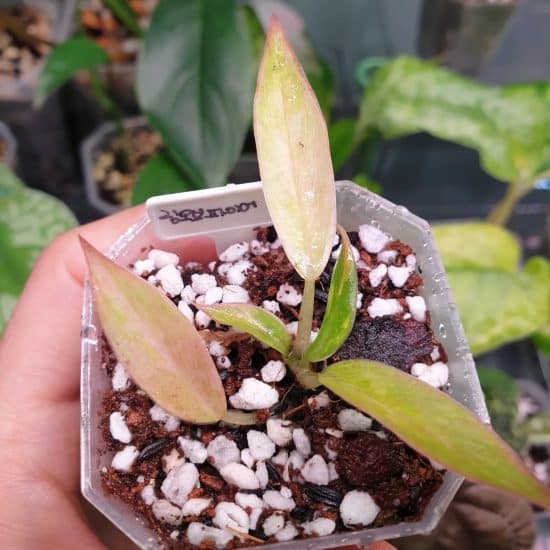
Propagating a Philodendron Ring of Fire, a rare plant, is often the only way to get a new one. Its thick stems and internodal spacing, however, make it difficult to propagate via stem cuttings. So we’re focusing on air layering with coconut coir instead. It’s super effective, especially for plants with thick stems, like the Philodendron Ring of Fire.
Air layering with coconut coir:
- Gather your materials: Grab some coco coir, plastic wrap, and gardening tape. The coir will hold moisture and encourage roots, the plastic wrap will hold the coir onto your stem, and the tape will secure both.
- Find the perfect spot. Look for a stem with a node, a growth point from which roots, leaves, and new stems grow. Aerial roots alone are not enough to propagate from, even though they look like they should function as taproots. Place a clean cut near the node. This will inspire the stem to produce roots.
- Wrap the coir around your cut stem. This helps create a moist environment for those roots to start growing. Continue to keep the coco coir moist but not too wet.
- Secure the coir with plastic wrap and sticky tape. This keeps the moisture in, but don’t wrap too tightly or you could prevent oxygen from reaching your node.
- Keep an eye out for new roots. This can take weeks or months, and even as long as a year. If it goes on a long time, it’s not a bad idea to change out your coir and plastic wrap.
- When a healthy root system has formed, snip the new plant from the mother plant with sterilized gardening tools.
- Pot the new plant in a container with well-draining soil and follow our Philodendron Ring of Fire care guidelines.
Common Issues
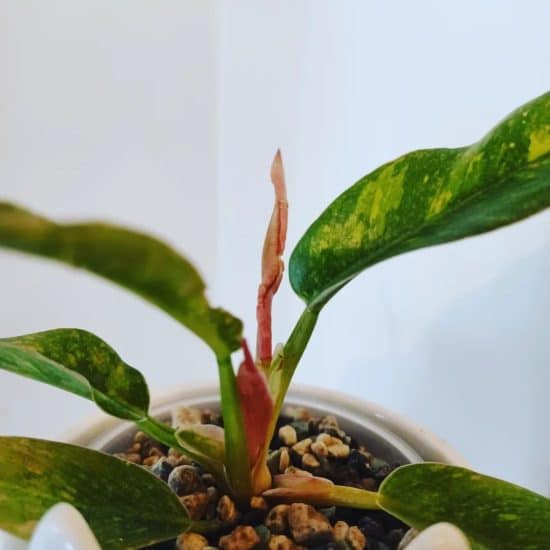
All plant lovers hope for healthy plants, but the occasional Ring of Fire issue is bound to happen eventually. We’ll cover how to fix some of the most common ones we see.
Slow-growing Plant
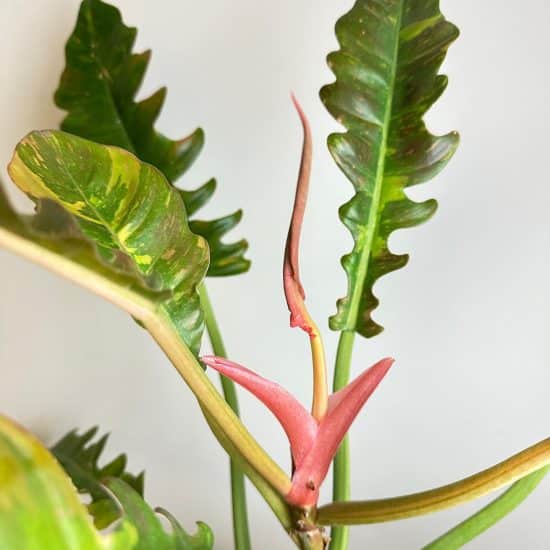
Philodendron Ring of Fire is a naturally slow-growing plant. If yours isn’t growing as fast as your other philodendron plants, don’t worry! That’s normal. But if you’ve had it for years and it’s not going anywhere, there may be causes.
If your Philodendron Ring of Fire displays slow growth or has trouble unfurling new leaves, it could be due to insufficient light, poor-quality water, or inadequate nutrients in the soil. If low-light conditions seem to be the issue, relocate your philodendron plant to a spot with brighter indirect sunlight to encourage healthy growth.
Water quality can also affect your Philodendron Ring of Fire plant’s growth, so avoid using tap water, which can harm your plant. Instead, opt for distilled or filtered water. Finally, make sure your plant receives the necessary nutrients by applying a well-balanced liquid fertilizer once a month during the growing season.
Leaf Spots
Small spots on your Philodendron Ring of Fire leaves may not necessarily be a reason for worry. In some instances, these spots are a result of the plant’s extrafloral nectaries releasing sap. However, if the number or size of the spots increases, it could indicate a fungal or bacterial infection.
To address this issue, remove any affected leaves using sterilized pruning shears and ensure adequate air circulation around your plant. If the problem continues or worsens, you might want to consider applying a fungicide or copper-based bactericide to help control the infection.
As always, follow the manufacturer’s instructions when using chemical treatments to ensure the safety and well-being of your Philodendron Ring of Fire. It’s best to keep your plant out of excessive sunlight during treatments to avoid chemical burn on the leaves.
Pests and Diseases
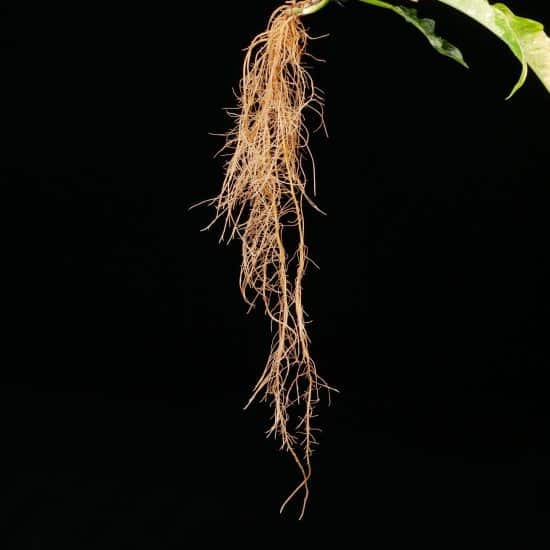
Thrips and Aphids
Thrips and aphids can also plague Ring of Fire plants. Luckily, the solutions for both are the same. These teeny critters feed on your Philodendron Ring of Fire’s sap. To spot them, look for tiny dark or yellowish bugs, usually hiding on the underside of Ring of Fire leaves. You might notice discolored or silvery patches.
Found thrips or aphids? No worries, just follow these steps:
- Isolate your plant to keep the bugs from spreading.
- Prune and toss any damaged leaves and stems.
- Give the plant a good spray with insecticidal soap or neem oil (carefully following the label’s instructions). Keep at it every few days until the thrips wave the white flag.
- Keep your Philodendron Ring of Fire out of direct sun while you treat it, and continue treatment if you see any stubborn thrips or aphids hanging around.
Spider Mites
Spider mites are a common pest that you may encounter with Philodendron Ring of Fire. You’ll recognize them by the thin webbing they create around your plant’s stems and base.
If you spot spider mites on your Ring of Fire, the steps are similar to a thrip infestation. Separate it from your other plants and give the plant a good spray with water. Remove stubborn mites with a damp cloth. Then, spray with a biological insecticide to ensure they won’t bother your plant anymore.
Root Rot
This common problem can sneak up on your Philodendron Ring of Fire, especially when you’re overwatering or not providing adequate drainage. Yellow leaves, wilting, and a funky smell from the soil are telltale signs that something’s amiss with the roots.
To tackle root rot, follow these steps:
- Gently remove the plant from its pot and inspect the roots. Healthy roots are white, firm, and have that fresh, earthy scent we all love.
- Snip away any black, mushy, or slimy roots using sterilized scissors.
- Repot your plant with fresh, well-draining soil (add some perlite, pumice, or LECA for better aeration and drainage). Make sure the new pot has drainage holes!
- Water your plant carefully until it bounces back, letting the top inch or two of soil dry out first.
Conclusion
That’s it for our Philodendron Ring of Fire care guide! You should now feel well-equipped to nurture this blazing addition to your indoor garden.
Philodendron Ring of Fire care summary:
- Provide bright, indirect light to maintain the plant’s vibrant colors.
- Maintain warm temperatures between 65-80°F (18-27°C) and high humidity levels of 60% or more.
- Use a well-draining potting mix and apply a balanced liquid fertilizer monthly during the growing season.
- Instead of taking a stem cutting, propagate using air layering with coconut coir to encourage new growth and expand your houseplant collection.
We hope this guide has been helpful and provided you with the knowledge and confidence you need to care for your Philodendron Ring of Fire. Don’t hesitate to reach out if you have any questions, and be sure to share your plant’s progress with us!
Here’s to a thriving garden that brings the heat!
FAQ
Is Philodendron Ring of Fire a crawler or climber?
The Philodendron Ring of Fire is primarily a climbing plant, and it loves to latch onto supports and grow upwards. To help your plant thrive, provide it with a pole, trellis, or any other sturdy climbing structure. The climbing nature of the Ring of Fire allows it to reach for the light it loves while also showcasing its vibrant foliage.
Is Philodendron Ring of Fire rare?
Yes, the Philodendron Ring of Fire is a rare and sought-after plant due to its unique appearance and difficult propagation.
Because of its rarity, the Philodendron Ring of Fire may come with a higher price tag than other philodendrons, but its distinct beauty makes it well worth the investment for plant lovers.
Is Philodendron Ring of Fire toxic?
Philodendron Ring of Fire is considered toxic by the ASPCA, as it belongs to the Philodendron genus, which is known to contain calcium oxalate crystals. You’ll want to keep Philodendron Ring of Fire and other toxic plants out of reach of children and pets to avoid accidental ingestion or contact.


